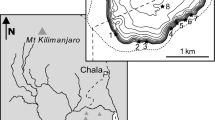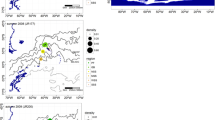Abstract
The Salton Sea is a highly saline lake that has long supported sportfishery and large populations of fish-eating birds. A study was initiated in 1999 to assess the status of orangemouth corvina (Cynoscion xanthulus), bairdiella (Bairdiella icistia) and tilapia (Oreochromis mossambicus × O. urolepis). Multimesh (50 × 2 m) gillnets were set at nine stations in 1999, ten stations in 2000 and six stations in 2002. These stations were sampled every two months in 1999, every three months in 2000 and once in 2002. O. mossambicus was the most abundant of the four species, with a maximum mean catch per unit effort (CPUE) 13.8 kg net−1 h−1 or 29.9 fish net−1 h−1 being observed at the river mouth stations in August 1999. From spring to summer, tilapia CPUE increased at nearshore and river mouth stations and decreased at pelagic stations, apparently reflecting migration away from midlake areas in response to anoxia or hypoxia caused by periodic springtime overturn events in deep waters. Tilapia catches in nearshore, river mouth and pelagic habitats were 83 and 60% males in 1999 and 2000, respectively. Tilapia catches in rivers in August 1999 averaged only 6% male. During 1999–2000, the tilapia population consisted essentially of only the 1995 and 2000 year classes. Harsh conditions at the Salton Sea have led to erratic reproduction and survival rates and unstable age structures for its resident fishes. Massive parasite infestations of fry and physiological stressors such as anoxia, high sulfide levels, high salinity and high and low temperatures are potential causes of the irregular recruitment and periodic dieoffs of tilapia. The abundance of all fish species declined over the years of study. Between 1999 and 2002, the late summer mean CPUEs for tilapia, bairdiella and orangemouth corvina at four nearshore stations dropped from 16 fish to 0.02 fish, from 4.7 fish net to 0.23 fish, and from 0.08 fish to 0.02 fish, respectively. During 2000–2003, parallel declines occurred in estimated numbers of adult fish involved in mass mortality events at the Sea. The boom-and-bust dynamics of tilapia and other fish populations in the Sea have major consequences for fish-eating bird populations, for other components of the ecosystem, and for the recreational value of the lake.
Similar content being viewed by others
References
Bagarinao, T. & I. Lantin-Olaguer, 1998. The sulfide tolerance of milkfish and tilapia in relation to fish kills in farms and natural waters in the Philippines. Hydrobiologia 382: 137–150.
Baras, E., C. Prignon, G. Gohounga & C. Melard, 2000. Phenotypic sex differentiation of blue tilapia under constant and fluctuating thermal regimes and its adaptive and evolutionary implications. Journal of Fish Biology 57: 210–223.
Barnes, J. T. & T. J. Foreman, 1994. Recent evidence for the formation of annual growth increments in the otoliths of young Pacific sardines (Sardinops gigax). California Fish and Game 80: 29–35
Black, G., 1988. Description of the Salton Sea Sport Fishery, 1982–1983. Inland fisheries Administrative Report, Number 88-9. Editor, Arthur C. Knutson, Jr., Inland Fisheries Division, Sacramento, California.
Bluhdorn, D. R. & A. H. Arthington, 1990. Somatic characteristics of an Australian population of Oreochromis mossambicus (Pisces: Cichlidae). Environmental Biology of Fishes 29: 277–291.
Bowen, S., 1980. Detrital nonprotein amino acids are the key to rapid growth of Tilapia in Lake Valencia, Venezuela. Science 207: 1216–1218.
Bruton, M. N. & R. E. Boltt, 1975. Aspects of the biology of Tilapia mossambica Peters (Pisces: Cichlidae) in a natural freshwater lake (Lake Sibaya, South Africa). Journal of Fish Biology 7: 423–445.
Caskey, L. L., 2002. Ecology of tilapia (Oreochromis mossambicus) in the Salton Sea, California. Master’s thesis, San Diego State University, 259 pp.
Cochrane, K. L., 1986a. Distribution of the three major species of fish in the Hartbeespoort Dam in relation to some environmental factors. South African Journal of Zoology 21: 177–182.
Cochrane, K. L., 1986b. Mortality of young-of-the-year Oreochromis mossambicus in Hartebeespoort Dam, South Africa. Journal of Fish Biology 29: 623–630.
Cohen, M., J. I. Morrison & E. P. Glenn, 1999. Haven or Hazard: The ecology and future of the Salton Sea. Pacific Institute for Studies in Development, Environment, and Security, California, USA, 63 pp.
Costa Pierce, B. & R. W. Doyle, 1997. Genetic identification and status of tilapia regional strains in southern California. In Costa-Pierce B. A. & J. E. Rakocy (eds), Tilapia Aquaculture in the Americas, Volume 1. World Aquaculture Society, Baton Rouge, Louisiana, 1–17.
Costa Pierce, B. & R. Riedel, 2000. Fisheries ecology of the tilapias in subtropical lakes of the United States. In Costa-Pierce B. A. & J. E. Rakocy (eds), Tilapia Aquaculture in the Americas, Volume 2. The World Aquaculture Society, Baton Rouge, Louisiana, 1–20.
Detwiler, P. M., M. F. Coe & D. M. Dexter, 2002. The benthic invertebrates of the Salton Sea: distribution and seasonal dynamics. Hydrobiologia 473: 139–160.
Friend, M., 2002. Avian disease at the Salton Sea. Hydrobiologia 473: 293–306.
González, M. R., C. M. Hart, J. Verfaillie & S. H. Hurlbert, 1998. Salinity and fish effects on Salton Sea microecosystems: water chemistry and nutrient cycling. Hydrobiologia 381: 105–128.
Hart, C. M., M. R. Gonzalez, E. P. Simpson & S. H. Hurlbert, 1998. Salinity and fish effects on Salton Sea microecosystems: zooplankton and nekton. Hydrobiologia 381: 129–152.
Hecht, T., 1980. A comparison of the otolith and scale methods of ageing and the growth of S. mossambicus (Pisces: Cichlidae) in a Venda impoundment (Southern Africa). South African Journal of Zoology 15: 222–228.
Hecht, T. & P. Zway, 1984. On the stunted Mozambique tilapia, Oreochromis mossambicus (Peters, 1852) (Pisces: Cichlidae) of the Matiovila Hot Spring, Kruger National Park. Koedoe 27: 25–38.
Hickling, C. F., 1960. The Malacca tilapia hybrids. Journal of Genetics 57: 1–10.
Holdren, G. C. & A. Montaño, 2002. Chemical and physical characteristics of the Salton Sea, California. Hydrobiologia 473: 1–21.
Hurlbert, A. H., K. Sturm, T. Anderson & S. H. Hurlbert, 2007. Fish and fish-eating birds at the Salton Sea: a century of boom and bust. Hydrobiologia (under review).
James, N. P. E. & M. N. Bruton, 1992. Alternative life-history traits associated with reproduction in Oreochromis mossambicus (Pisces: Cichlidae) in small water bodies of the eastern Cape, South Africa. Environmental Biology of Fishes 34: 379–392.
Kuperman, B. I. & V. E. Matey, 1999. Massive infestation by Amyloodinium ocellatum (Dinoflagellida) of fish in a highly saline lake, Salton Sea, California, USA. Diseases of Aquatic Organisms 39: 65–73.
Kuperman, B. I., V. E. Matey & S. B. Barlow, 2002. Flagellate Cryptobia branchialis (Bodonida: Kinetoplastida) ectoparasite of tilapia from the Salton Sea. Hydrobiologia 473: 93–102.
Kuperman, B. I., V. E. Matey & S. H. Hurlbert, 2001. Parasites of fish from the Salton Sea, California, USA. Hydrobiologia 466: 195–208.
Le Roux, P. J., 1961. Growth of Tilapia mossambicus (Peters) in some Transvaal Impoundments. Hydrobiologia 18: 165–175.
Maitipe, P. & S. S. DeSilva, 1985. Switches between zoophagy, phytophagy and detritivory of Sarotherodon mossambicus (Peters) populations in 12 man-made Sri Lankan lakes. Journal of Fish Biology 26: 49–61.
Moreau, M. F., J. Surico-Bennett, M. Vicario-Fisher, D. Crane, R. Gerards, R. M. Gersberg, S. H. Hurlbert, 2007. Contaminants in tilapia (Oreochromis mossambicus) from the Salton Sea, California, in relation to human health, piscivorous birds and fish meal production. Hydrobiologia 576:127–165.
Morgan, P., 1972. Causes of mortality in the endemic tilapia of Lake Chilwa (Malawi). Hydrobiologia 40: 101–119.
Noakes, D. L. G., E. K. Balon, 1982. Life histories of tilapias: an evolutionary perspective, pp. 61–82. In Pullin R. S. V. & R. H. Lowe-McConnell (eds), The Biology and Culture of Tilapias. ICLARM Conference Proceedings 7. International Center for Living Aquatic Resources Management, Manila, Philippines, 432 pp.
Perry, T., 1999. Divers examine wreck of plane in Salton Sea. The Los Angeles Times, Los Angeles, California, June 15, 1999.
Popper, D. & T. Lichatowich, 1975. Preliminary success in predator control of Tilapia mossambica. Aquaculture 5: 213–214.
Riedel, R. & B. Costa-Pierce, 2001. Review of the fisheries of the Salton Sea, California, USA: past, present and future. Hydrobiologia 9: 239–270.
Riedel, R., L. Caskey & B. A. Costa-Pierce, 2002. Fish biology and fisheries ecology of the Salton Sea, California. Hydrobiologia 473: 229–244.
Riedel, R., L. Helvenston & B. Costa-Pierce, 2001. Fish biology and fisheries ecology of the Salton Sea. Final Report May 1, 2001. Salton Sea Authority, Department of Interior.
Sardella, B. A., J. Cooper, R. Gonzalez & C. J. Brauner, 2004. The effect of temperature on the salinity tolerance of juvenile Mozambique tilapia hybrids (Oreochromis mossambicus × O. urolepis hornorum). Comparative Biochemistry and Physiology A137: 621–629.
Simpson, E. P., M. R. González, C. M. Hart & S. H. Hurlbert, 1998. Salinity effects on Salton Sea microecosystems: benthos. Hydrobiologia 381: 153–177.
St. Amant, J., 1966. Addition of Tilapia mossambica Peters to the California fauna. California Fish and Game Bulletin 52: 54–55.
Tiffany, M. A., B. K. Swan, J. M. Watts & S. H. Hurlbert, 2001. Metazooplankton dynamics in the Salton Sea, 1997–1999. Hydrobiologia 473: 103–120.
Tiffany, M. A., M. R. González, B. K. Swan, S. H. Hurlbert, 2007. Phytoplankton dynamics in the Salton Sea, California, 1997–1999. Hydrobiologia (under review).
Walker, B. W., 1961. The ecology of the Salton Sea, California, in relation to the sportfishery. California Department of Fish and Game, Fish Bulletin 113: 1–203.
Wang , Li-Hsueh & C. Tsai, 2000. Effects of temperature on the deformity and sex differentiation of tilapia, Oreochromis mossambicus. Journal of Experimental Zoology 286: 534–537.
Watts, J. M., B. K. Swan, M. A. Tiffany & S. H. Hurlbert, 2001. Thermal mixing, and oxygen regimes of the Salton Sea, California. Hydrobiologia 466: 159–176.
Weyl, O. L. F. & T. Hecht, 1998. The biology of Tilapia rendalii and Oreochromis mossambicus (Pisces: Cichlidae) in a subtropical lake in Mozambique. South African Journal of Zoology 33: 178–188.
Wokoma, K., I. E. Marioghae, 1996. Survival of Tilapia guineensis under conditions of low dissolved oxygen and low pH, pp. 442–448. In R. S. V. Pullin, J. Lazard, M. Legendre, J. B. Amon Kothias & D. Pauly (eds), The Third International Symposium on Tilapia in Aquaculture, ICLARM Conference Proceedings 41, 575 pp.
Author information
Authors and Affiliations
Corresponding author
Additional information
Guest Editor: John M. Melack
Saline Waters and their Biota
Rights and permissions
About this article
Cite this article
Caskey, L.L., Riedel, R.R., Costa-Pierce, B. et al. Population dynamics, distribution, and growth rate of tilapia (Oreochromis mossambicus) in the Salton Sea, California, with notes on bairdiella (Bairdiella icistia) and orangemouth corvina (Cynoscion xanthulus). Hydrobiologia 576, 185–203 (2007). https://doi.org/10.1007/s10750-006-0301-2
Issue Date:
DOI: https://doi.org/10.1007/s10750-006-0301-2




